The following image shows the Match and Merge Job Analysis section of the Overview tab: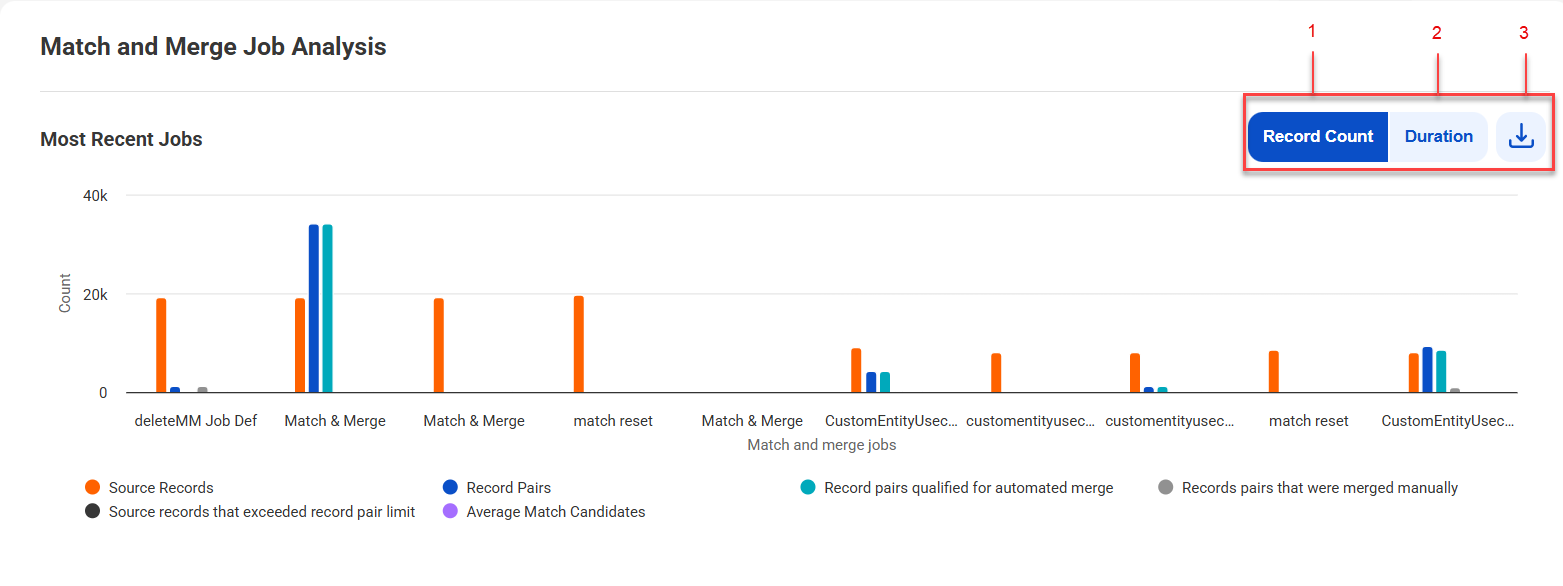

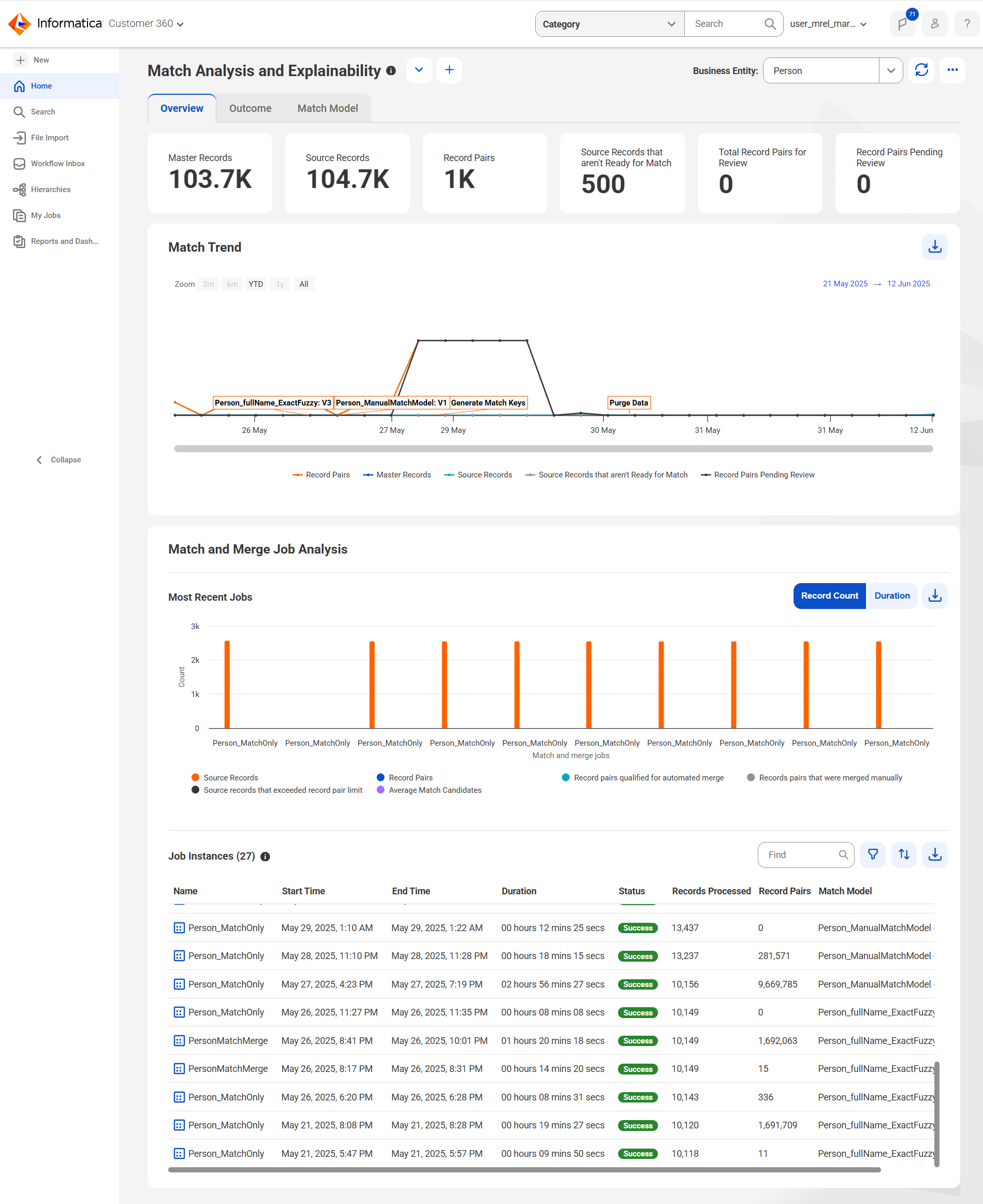
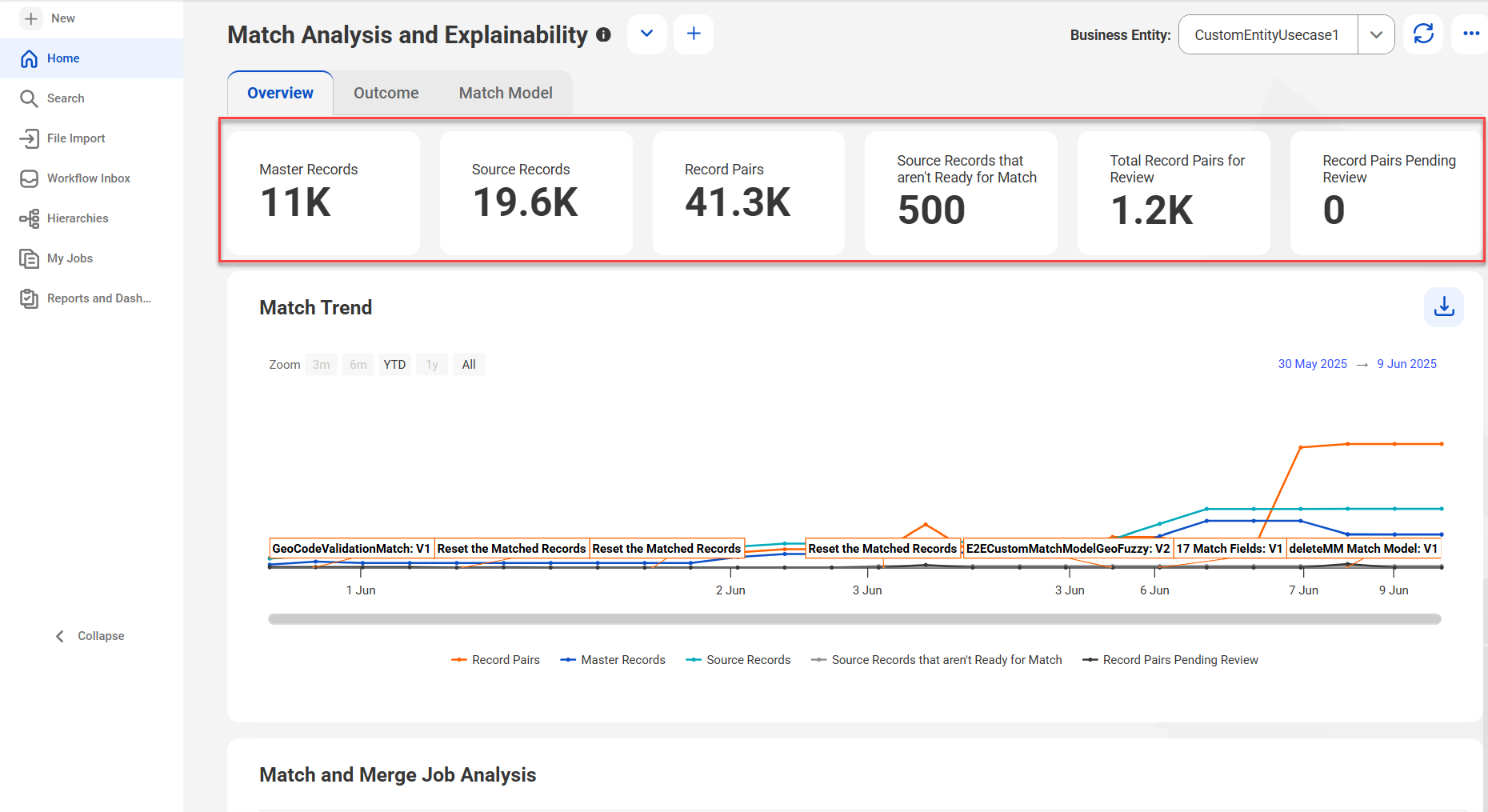
Name | Description |
|---|---|
Master Records | Total number of master records. |
Source Records | Total number of source records. |
Record Pairs | Total number of record pairs that the match process has identified. |
Source Records that aren't Ready for Match | Number of source records that are set to the NOT_READY_FOR_MATCH state by the users. |
Total Record Pairs for Review | Total number of record pairs that are identified for manual review. |
Record Pairs Pending Review | Total number of record pairs that are pending review. For example, if 1000 record pairs are identified for manual review and 100 record pairs are reviewed, then the record pairs pending review are 900. |
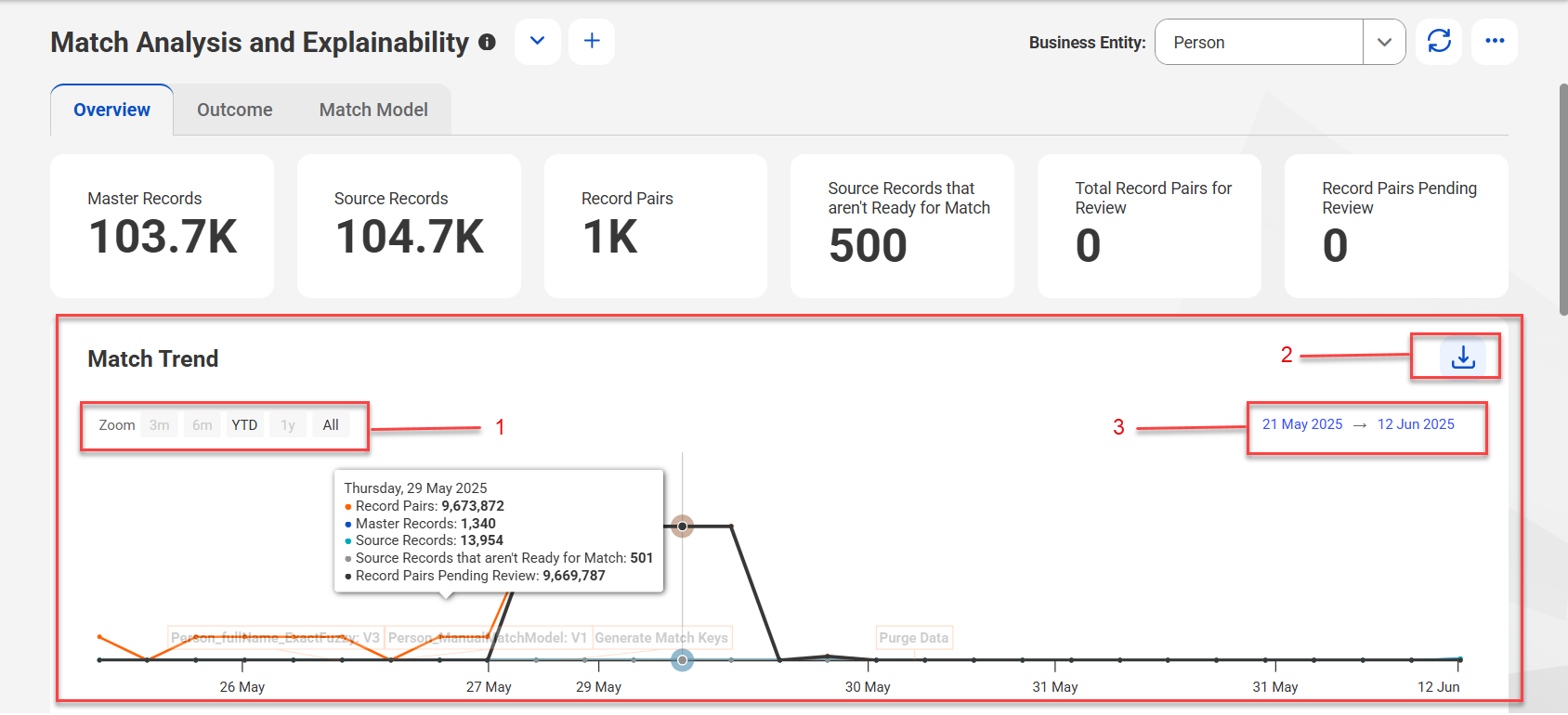
User Interface Elements | Description |
|---|---|
Zoom | View data by months, year, or all data. |
Export Data | Exports key metrics of the jobs to a CSV file, that includes the job type and job description. |
Date Range | Start and end dates to view the match trend. |

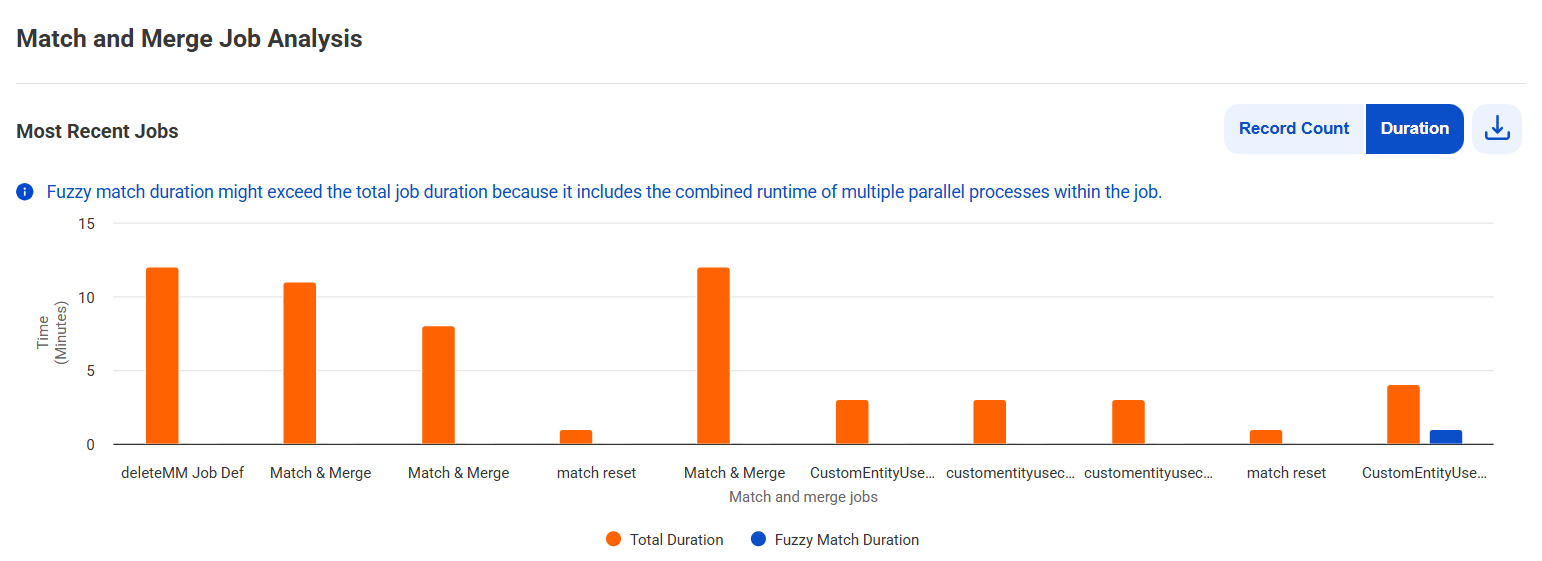
Job Details | Description |
|---|---|
Record Count | Displays bar graphs for metrics, such as the number of source records, record pairs, source records that exceed record pair limit, record pairs qualified for automated merge, and record pairs merged manually for each job using the bar chart. |
Duration | Displays bar graphs for metrics, such as the total duration each job took to complete and total duration a job configured with fuzzy match took to complete. |
Export Data | Exports details of the most recent jobs to a CSV file. The CSV file includes the latest 10 jobs run for the business entity and includes details, such as number of source records, record pairs, record pairs that were already merged or qualified for automated merge. It also includes the total and fuzzy match duration for each job. |
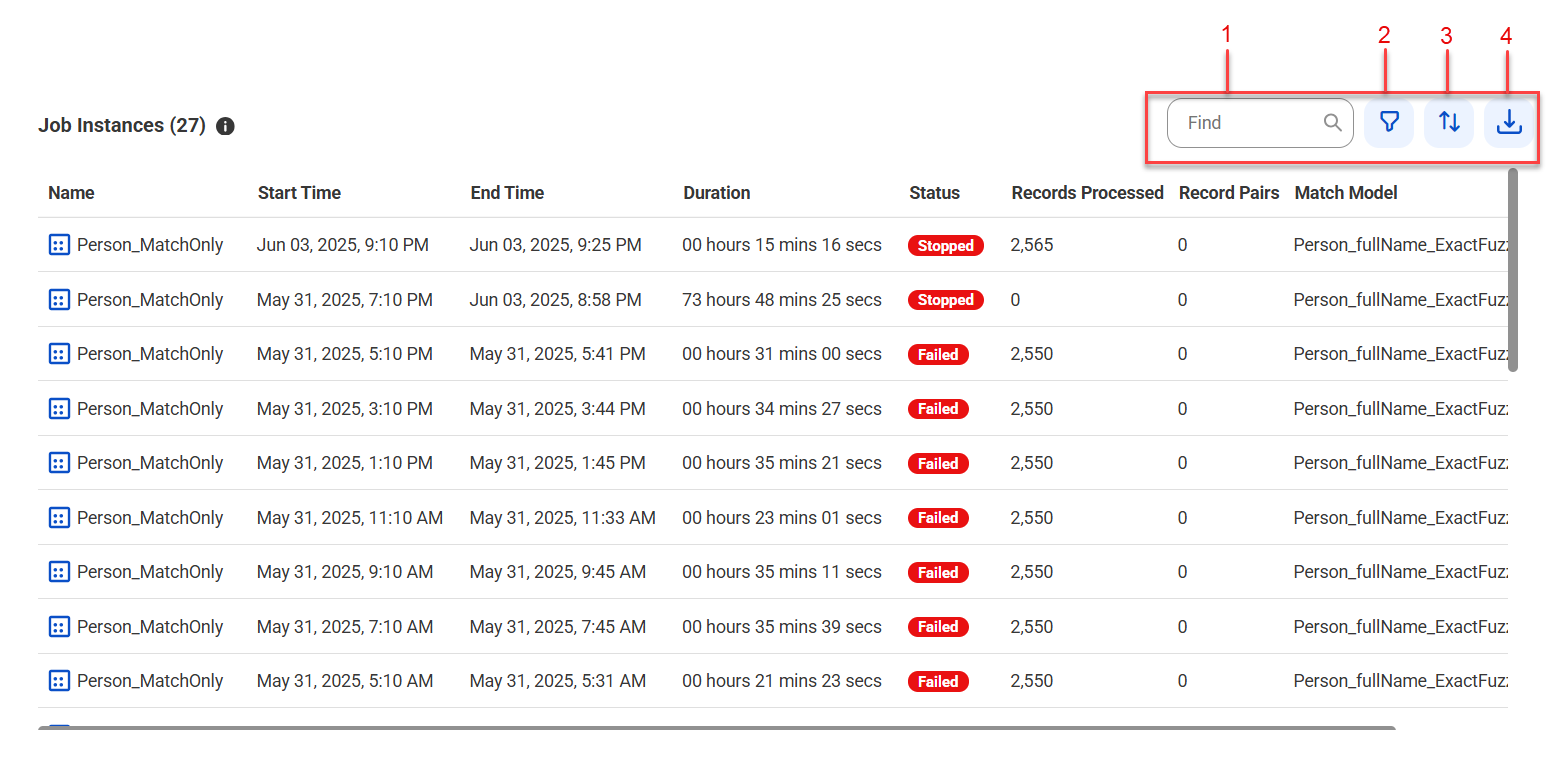
Job Detail | Description |
|---|---|
Name | Name of the job instance. |
Start Time | Date and time when the job started. |
End Time | Date and time when the job ended. |
Duration | Total time taken to complete the job. |
Status | Status of the job instance. |
Records Processed | Number of records that the job processed. |
Record Pairs | Number of record pairs that the job generated. |
Match Model | Name of the match model that the job used. |
User Interface Elements | Description |
|---|---|
Find | Searches jobs based on the job instance name or the match model name. |
Filter | Filters jobs based on duration, status, records processed, record pairs, and match models. |
Sort | Sorts jobs in ascending or descending order based on a selected column. |
Export Data | Exports details of all job instances to a CSV file. |
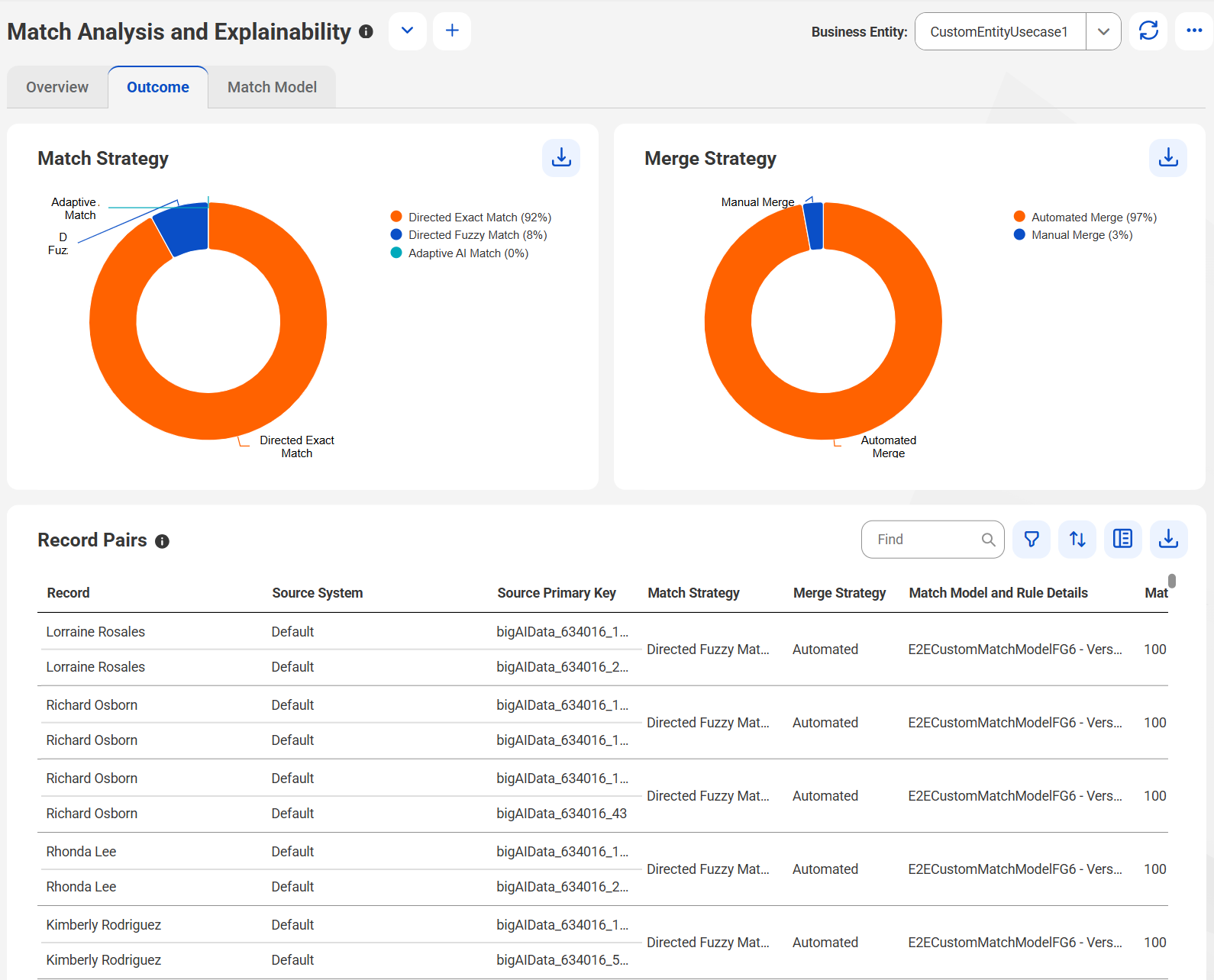
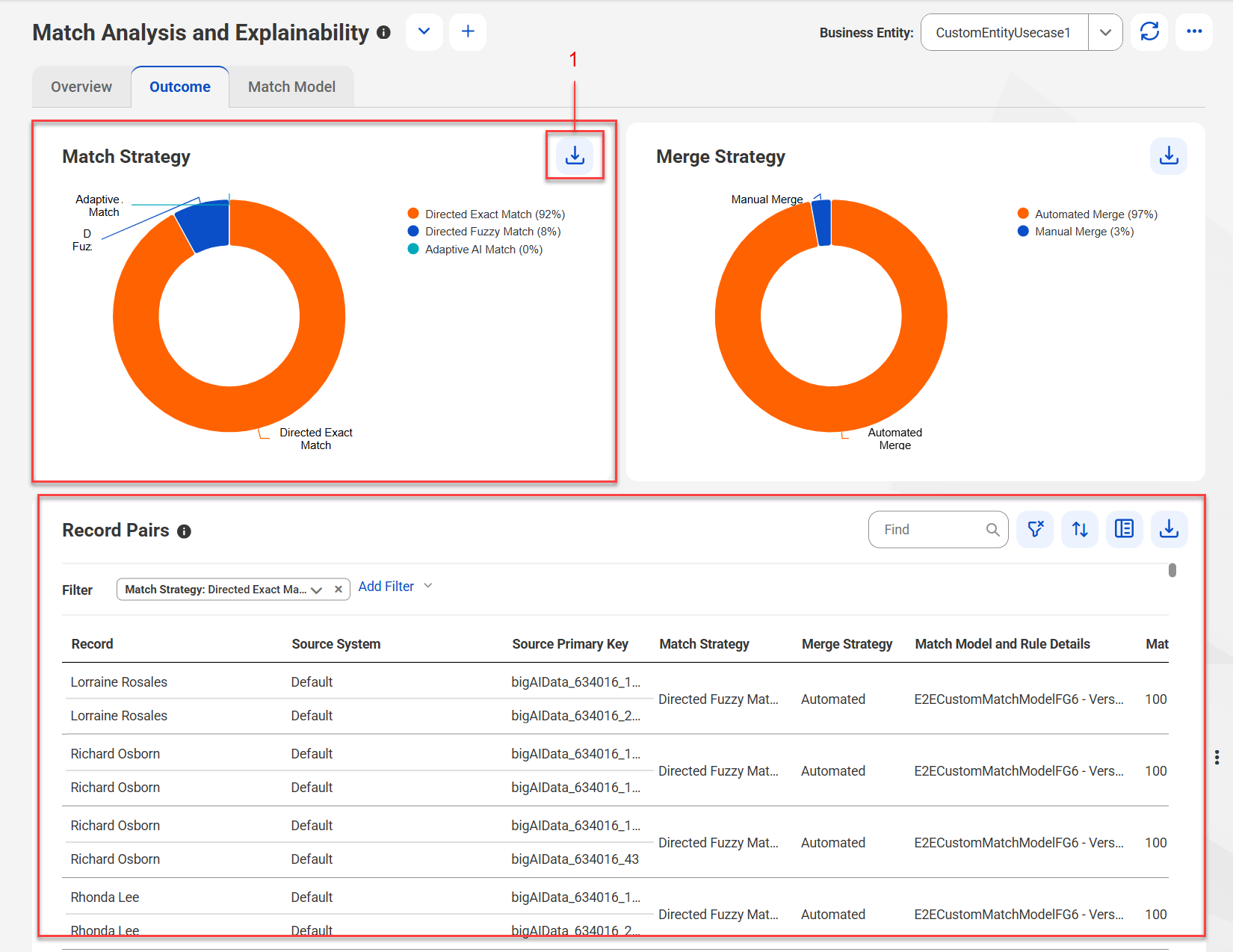
User Interface Elements | Description |
|---|---|
Export Data | Exports details, such as number and percentage of record pairs generated based on each match strategy to a CSV file. |
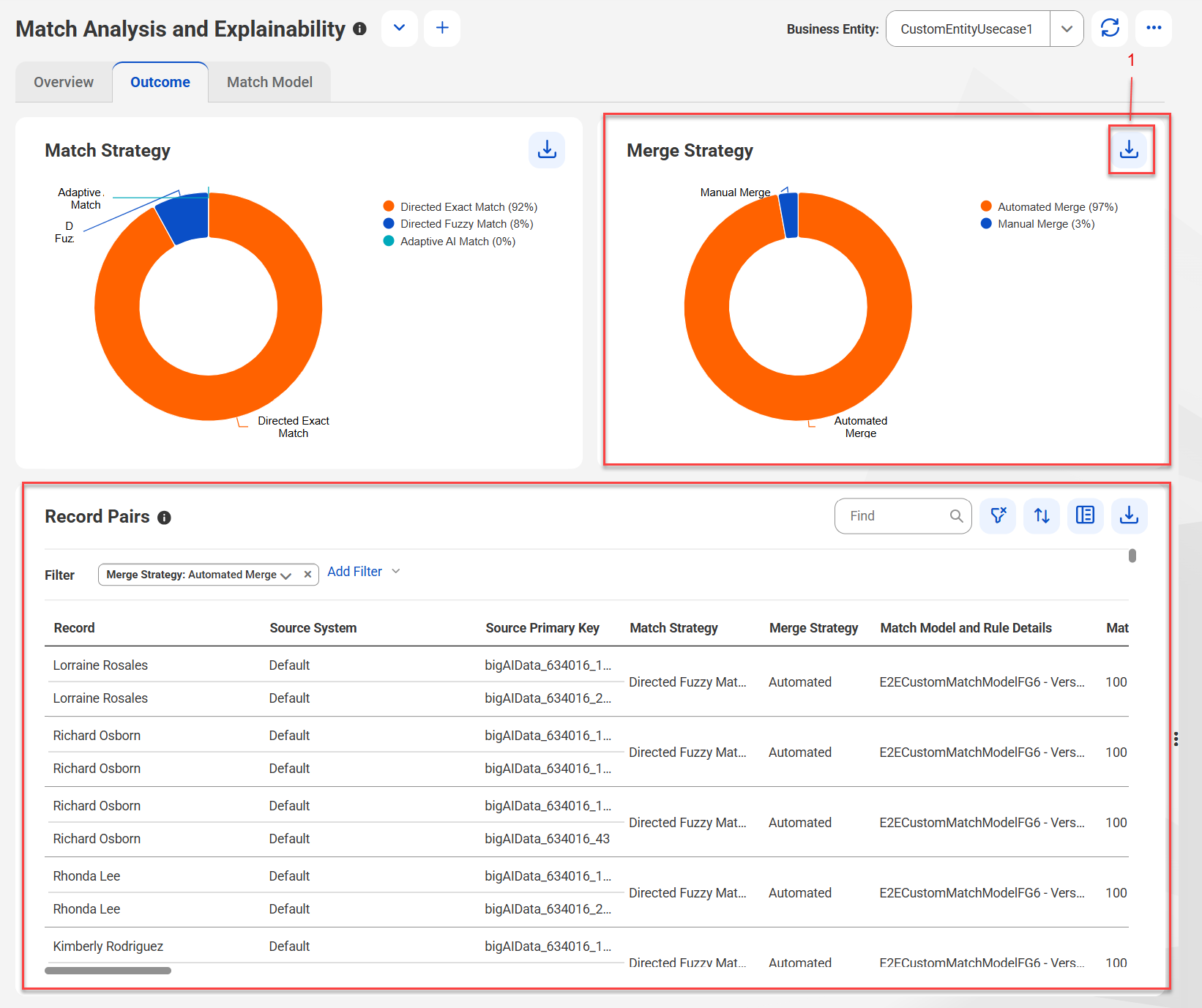
User Interface Elements | Description |
|---|---|
Export Data | Exports details, such as the number and percentage of record pairs generated based on each merge strategy to a CSV file. |
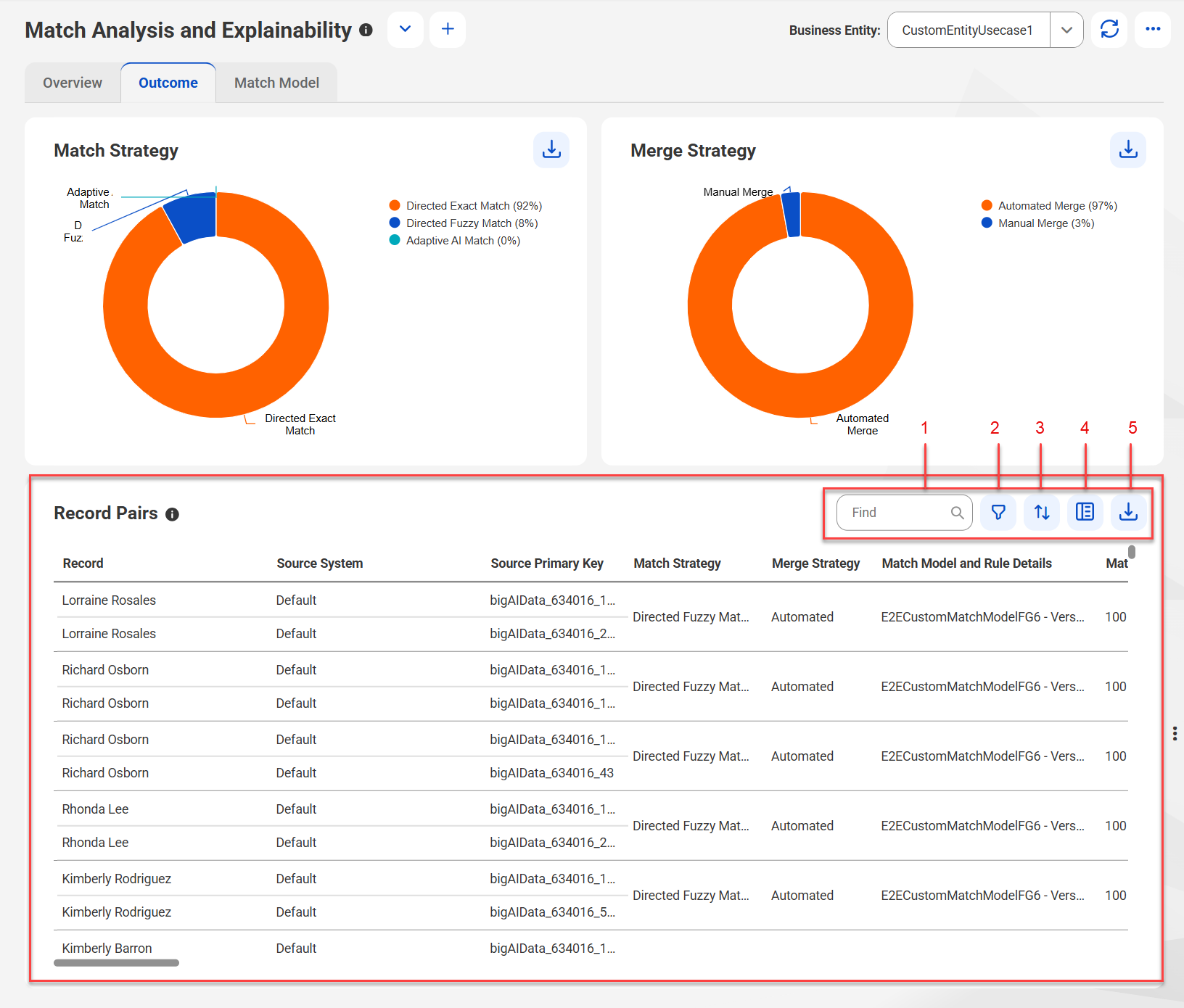
Job Detail | Description |
|---|---|
Record | Field values of the record pairs. |
Source System | Source system associated with the record pairs. |
Source Primary Key | Unique identifier of the source record. |
Match Strategy | Type of matching that the directed AI match rule performs, such as exact, fuzzy, or Adaptive AI. |
Merge Strategy | Action to perform during the merge process. The values are Manual and Automated. |
Match Model and Rule Details | Name of the match model and the directed AI match rule that the job used. |
Match Score | Score that indicates how similar the record pairs are. |
Matched Date | Date when the record pairs were matched. |
Match Fields | Business entity fields of the source records based on which the record pairs are matched. |
User Interface Elements | Description |
|---|---|
Find | Searches the record pairs based on the field value in the Records column. |
Filter | Filters record pairs based on source system, match strategy, merge strategy, match model and rule details, total match score, and matched date. You can also select sections of the pie chart to apply filters. |
Sort | Sorts the record pairs in ascending or descending order based on a selected column name. |
Show Additional Details | Displays the details of a selected record pair in the Record Pair Details section. |
Export Data | Exports record pair details to a CSV file. |
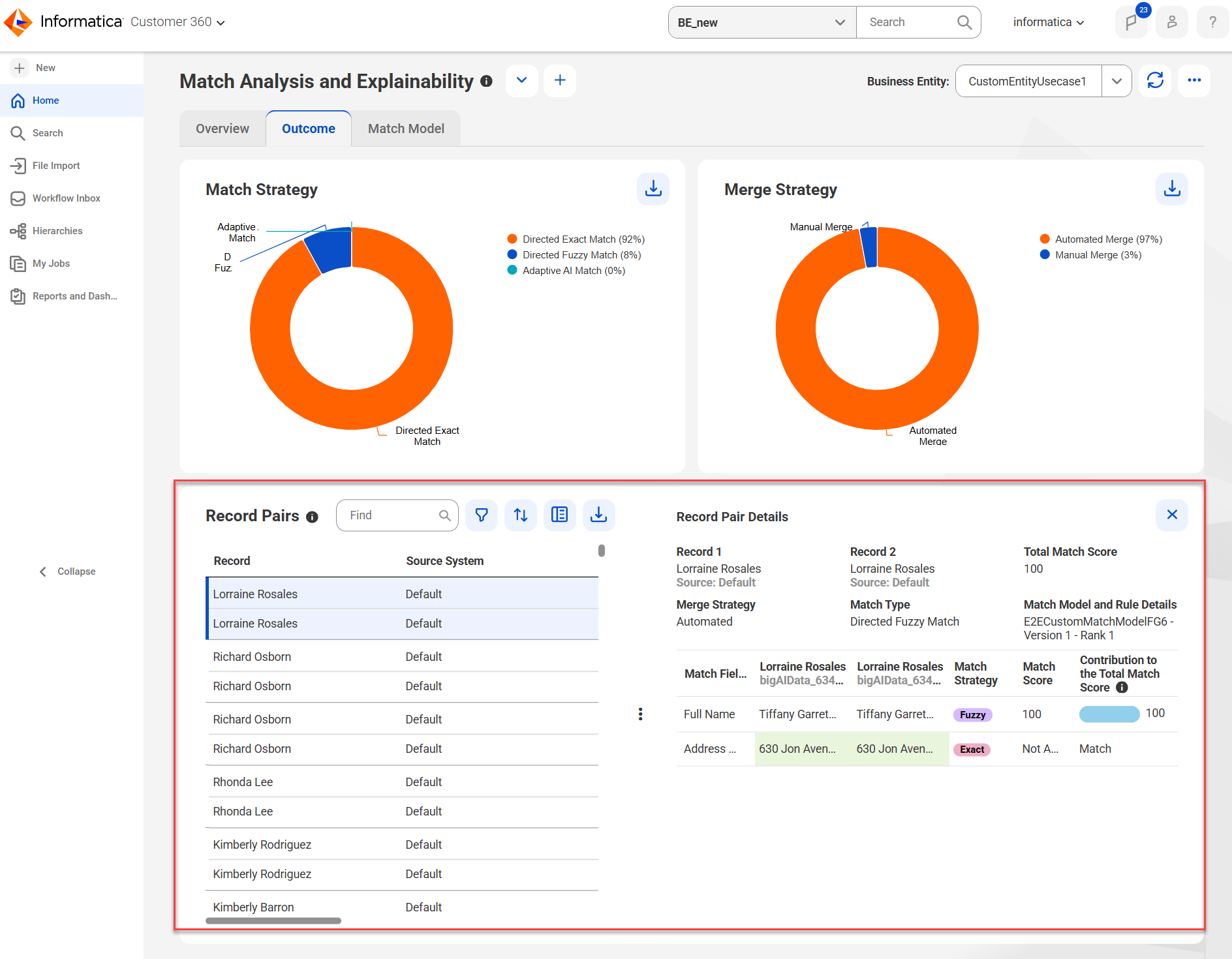
Record Pair Details | Description |
|---|---|
Record 1 | Name of the first source record in the selected record pair. |
Record 2 | Name of the second source record in the selected record pair. |
Total Match Score | Score that indicates how similar the record pairs are. The value is the sum of match scores of fuzzy match fields. Note: A decimal value is rounded off to display the total match score. |
Merge Strategy | Action to perform during the merge process. The values are Manual and Automated. |
Match Type | Type of matching that the directed AI match rule uses, such as directed AI match or adaptive AI match. |
Match Model and Rule Details | Name of the match model and the directed AI match rule that the job used. |
Match Fields | Name of the business entity fields that the directed AI match rule uses for matching. |
Match Strategy | Type of match that the directed AI match rule performs. |
Match Score | Score that indicates how similar the match fields of the record pairs are. Applicable to directed AI match rules with the fuzzy match strategy. |
Contribution to the Total Match Score | Match status for exact match fields, and shows the match score contribution of fuzzy match fields to the total match score. |
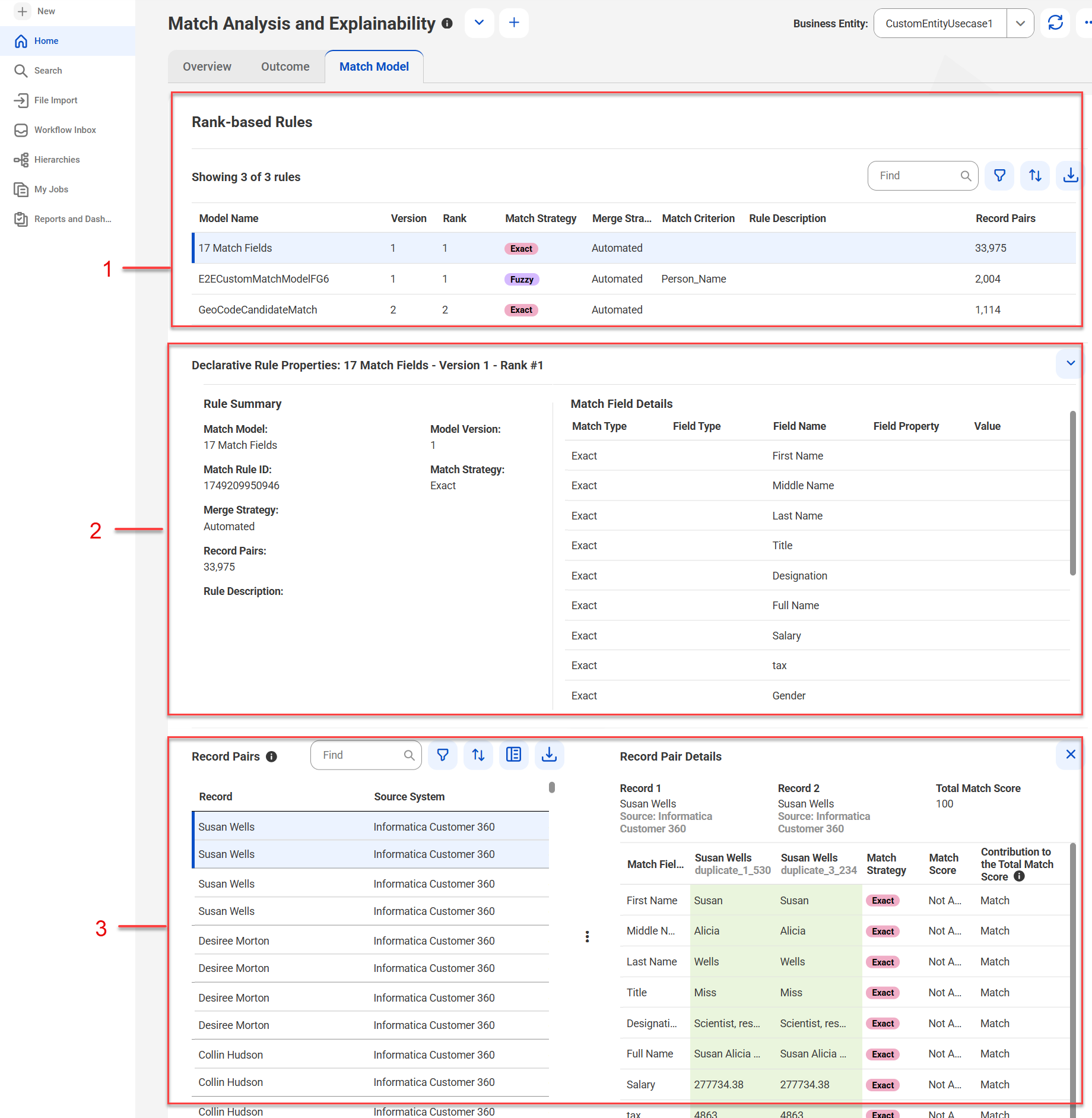

Name | Description |
|---|---|
Model Name | Name of the match model that contains the directed AI match rule. |
Version | Version of the match model. |
Rank | Execution order of the directed AI match rule in the match model. |
Match Strategy | Type of match that the directed AI match rule performs. |
Merge Strategy | Action to perform during the merge process. The values are Manual and Automated. |
Match Criterion | Type of data to use for matching. Applicable to directed AI match rules with the fuzzy match strategy. |
Rule Description | Short description to identify a directed AI match rule. |
Record Pairs | Number of record pairs that the directed AI match rule identified. |
User Interface Elements | Description |
|---|---|
Find | Search the directed AI match rules based on the column values. |
Filter | Filter directed AI match rules based on the column values. |
Sort | Sorts the directed AI match rules in ascending or descending order based on the selected column name. |
Export Data | Export details of the directed AI match rules to a CSV file. The CSV file includes properties of directed AI match rules, such as model name, version, and match criterion. |
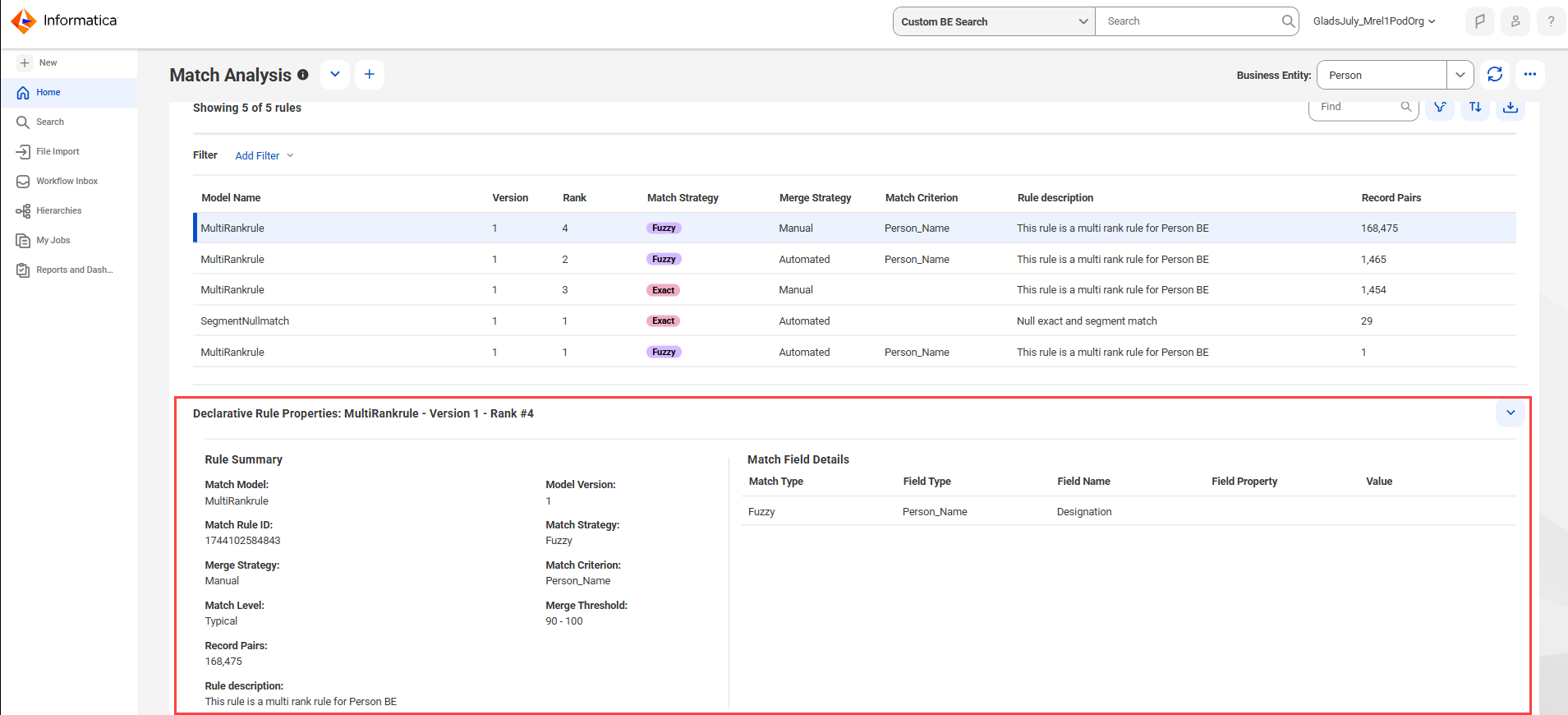
Declarative Rule Property | Description |
|---|---|
Match Model | Name of the match model that contains the directed AI match rule. |
Match Rule ID | System-generated identifier of the directed AI match rule. |
Merge Strategy | Action to perform during the merge process. The values are Manual and Automated. |
Match Level | Level of fuzzy matching performed on the data. |
Record Pairs | Number of record pairs that the directed AI match rule identified. |
Rule Description | Short description that explains the directed AI match rule. |
Model Version | Version of the match model. |
Match Strategy | Type of match that the directed AI match rule uses, such as exact or fuzzy. |
Match Criterion | Type of data to use for matching. Applicable to directed AI match rules with the fuzzy match strategy. |
Merge Threshold | Range of match scores used to identify record pairs as a match. Applicable to directed AI match rules with the fuzzy match strategy. |
Declarative Rule Property | Description |
|---|---|
Match Type | Type of match that the directed AI match rule uses, such as exact or fuzzy. |
Field Type | Type of data that the match field contains. Applicable to directed AI match rules with the fuzzy match strategy. |
Field Name | Name of the business entity field that the directed AI match rule uses for matching. Applicable to directed AI match rules with the fuzzy match strategy. |
Field Property | Additional properties configured for the match field, such as segment matching or null matching. |
Value | Value to identify segment data for matching. |
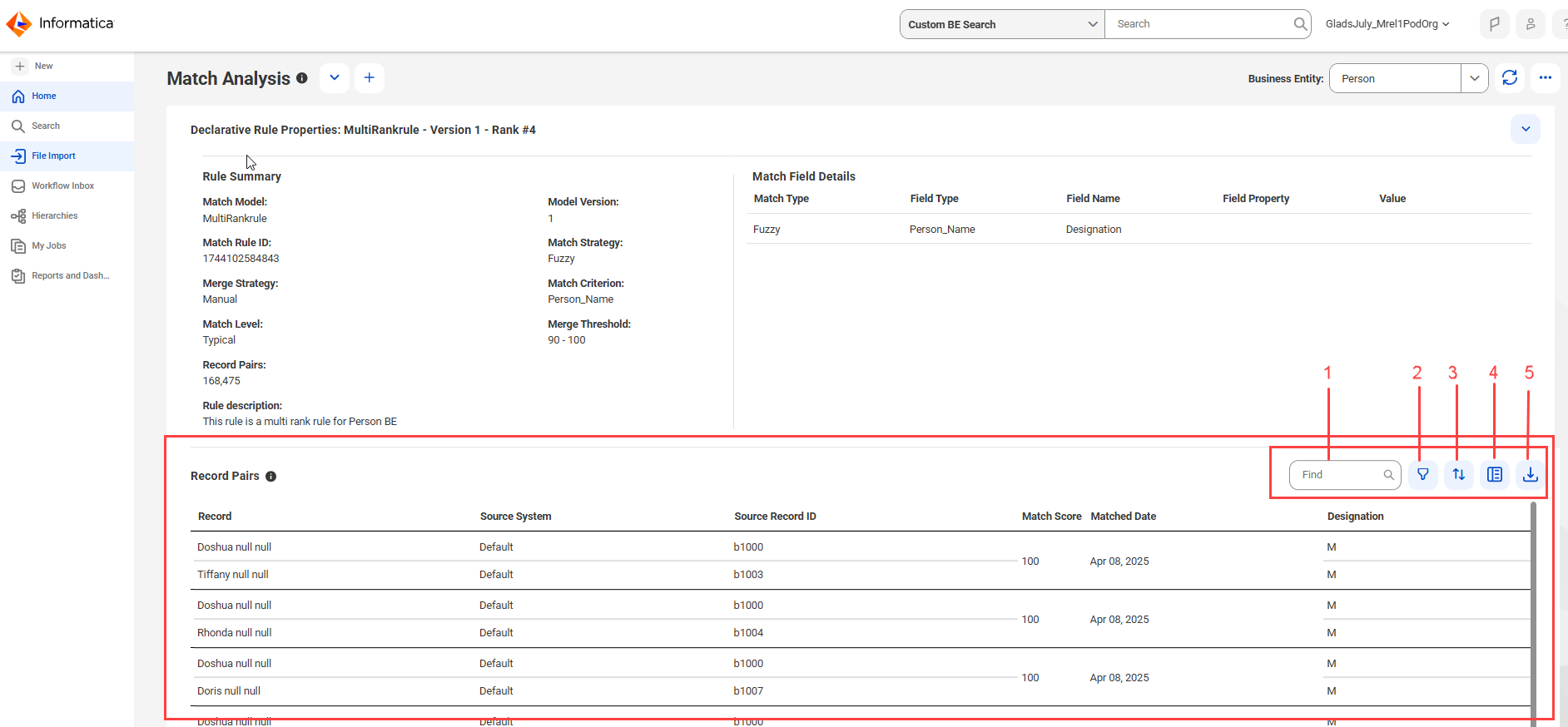
Record Pair Property | Description |
|---|---|
Record | Display field values of the record pairs. |
Source System | Source system associated with the record pairs. |
Source Record ID | Unique identifier of the record. |
Match Score | A score that indicates how similar the record pairs are. |
Matched Date | Date when the record pairs were matched. |
Match Fields | Business entity fields of the source records based on which the record pairs are matched. |
User Interface Elements | Description |
|---|---|
Find | Search the record pairs based on the column values. |
Filter | Filter record pairs based on column values. |
Sort | Sorts the record pairs in ascending or descending order based on the selected column name. |
Show Additional Details | Displays additional details of a selected record pair in the Record Pair Details section. |
Export Data | Export record pair details to a CSV file. |

Record Pair Details | Description |
|---|---|
Record 1 | Name of the first source record in the selected record pair. |
Record 2 | Name of the second source record in the selected record pair. |
Merge Strategy | Action to perform during the merge process. The values are Manual and Automated. |
Total Match Score | Score that indicates how similar the record pairs are. The value is the sum of the match scores of fuzzy match fields. Note: For a decimal value, the value is rounded off to show the total match score. |
Match Fields | Name of the business entity fields that the directed AI match rule uses for matching. |
Match Strategy | Type of match that the directed AI match rule performs. |
Match Score | Score that indicates how similar the match fields of the record pairs are. Applicable to directed AI match rules with the fuzzy match strategy. |
Contribution to the Total Match Score | Match status for the exact match fields, and displays the match score contribution of fuzzy match fields to the total match score. |